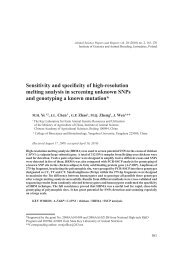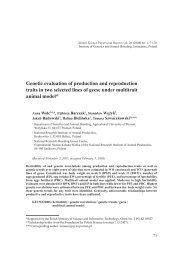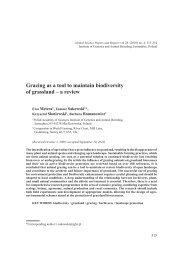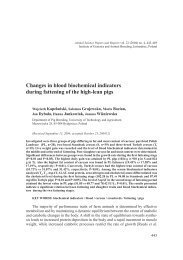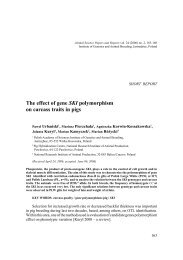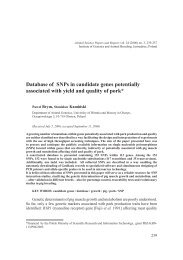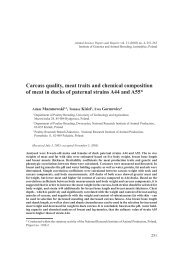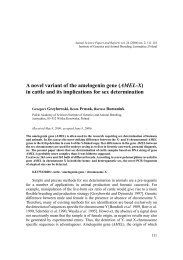K. Jaszczak et al. Photo 6. Pseudostratified cyl<strong>in</strong>drical epithelium with long stereocilia l<strong>in</strong><strong>in</strong>g ductus epididymis. H and E; × 40. Photo 7. Cross-section of the right ductus epididymis with numerous epithelial folds.No <strong>sex</strong> cells <strong>in</strong> the lumen of the duct. H and E; × 250. stereocilia were seen on their upper surface. No <strong>sex</strong> cells were found <strong>in</strong> the lumen of both epididymes (Photo 7). Thus the gonads were assessed as fully sterile. The affected <strong>horse</strong> was diagnosed as hav<strong>in</strong>g <strong>XX</strong> <strong>sex</strong> <strong>reversal</strong> syndrome on the basis of female karotype <strong>64</strong>,<strong>XX</strong> and presence of two <strong>in</strong>ter-abdom<strong>in</strong>al testes and ambiguous external genitalia. PCR amplification of the <strong>SRY</strong> gene was <strong>negative</strong> <strong>in</strong> all studied tissues, <strong>in</strong>clud<strong>in</strong>g testes. The genetic mechanism by which testes development occurs <strong>in</strong> the absence of the <strong>SRY</strong> gene is unclear. There is a possibility that other genes than <strong>SRY</strong> might be responsible, but they have not been detected up to now [Buoen et al 2000, Vaughan et 386
Sex <strong>reversal</strong> <strong>in</strong> a <strong>horse</strong> al. 2001]. It is possible that mutations <strong>in</strong> an autosomal and X-l<strong>in</strong>ked genes allow the testes development <strong>in</strong> the absence of <strong>SRY</strong> [Vaiman and Pailhoux 2000]. Some studies have shown that Sox9 and Wnt-4 are candidates for <strong>sex</strong> <strong>reversal</strong> [Va<strong>in</strong>io et al. 1999, Q<strong>in</strong> and Bishop 2005]. It is proposed that <strong>SRY</strong>-<strong>negative</strong> <strong>XX</strong> <strong>sex</strong> <strong>reversal</strong> syndrome is <strong>in</strong>herited <strong>in</strong> the <strong>horse</strong> [Buoen et al. 2000]. The <strong>case</strong> described <strong>in</strong> this study is the first report on <strong>SRY</strong><strong>negative</strong> <strong>XX</strong> <strong>sex</strong> <strong>reversal</strong> <strong>in</strong> the <strong>Konik</strong> <strong>Polski</strong> Horse. It is sporadic <strong>case</strong> rather and not familial occurrence. 1. 2. 3. 4. 5. 6. 7. 8. 9. 10. 11. 12. 13. References BANNASCH D, RINALDO C, MILLON L, LATSON K, SPANGLER T, HUBBERTY S, GALUPPO L, LOWENSTINE L., 2007 – <strong>SRY</strong> <strong>negative</strong> <strong>64</strong>,<strong>XX</strong> <strong>in</strong>ter<strong>sex</strong> phenotype <strong>in</strong> an American saddlebred <strong>horse</strong>. The Veter<strong>in</strong>ary Journal 173 (2), 437-439 BUOEN LC, ZHANG T.Q, WEBER A.F, RUTH G.R. 2000 – <strong>SRY</strong>-<strong>negative</strong>, <strong>XX</strong> <strong>in</strong>ter<strong>sex</strong> <strong>horse</strong>s: the need for pedigree studies to exam<strong>in</strong>e the mode of <strong>in</strong>heritance of the condition. Equ<strong>in</strong>e Veter<strong>in</strong>ary Journal 32, 78-81. HIROTA K., PIUMI F., SATO F., ISHIDA N., GUÉRIN G., MIURA N., HASEGAWA T., 2001 – FISH assignment of two equ<strong>in</strong>e BAC clones conta<strong>in</strong><strong>in</strong>g <strong>SRY</strong> and ZFY. Animal Genetics 32, 326- 327. KENT M.G., SCHNELLER H.E., HEGSTED R.L., JOHNSTON S.D., WACHTEL S.S., 1988 – Concentration of serum testosterone <strong>in</strong> XY <strong>sex</strong> reversed <strong>horse</strong>s. Journal of Endocr<strong>in</strong>ological Investigation 11, 609-613. MEYERS-WALLEN V.N., 2006 – Genetics, genomics, and molecular biology of <strong>sex</strong> determ<strong>in</strong>ation <strong>in</strong> small animals. Theriogenology 66, 1655-1658. MEYERS-WALLEN V.N, HURTGEN J., SCHLAFER D., TULLENERS E., CLELAND W.R, RUTH G.R, ACLAND G.M., 1997 – Sry-<strong>negative</strong> <strong>XX</strong> true hermaphroditism <strong>in</strong> a Pasa F<strong>in</strong>o <strong>horse</strong>. Equ<strong>in</strong>e Veter<strong>in</strong>ary Journal 29, 404-408. MILLIKEN J.E., PACCAMONTI D.L., SHOEMAKER S., GREEN W.H., 1995 – <strong>XX</strong> male pseudohermaphroditism <strong>in</strong> a <strong>horse</strong>. Journal of the American Veter<strong>in</strong>ary Medical Association 207, 77-79. PAILHOUX E., VIGIER B., CHAFFAUX S., SERVEL N., TAOURIT S., FURET J.P, FELLOUS M., GROSCLAUDE F., CRIBIU E.P., COTINOT C., VAIMAN D., 2001a – A 11.7-kb deletion triggers <strong>in</strong>ter<strong>sex</strong>uality and polledness <strong>in</strong> goats. Nature Genetics 29, 453-458. PAILHOUX E., PARMA P., SUNDSTRÖM J., VIGIER B., SERVEL N., KUOPIO T., LOCATELLI A., PELLINIEMI L.J., COTINOT C., 2001b – Time course of female-to-male <strong>sex</strong> <strong>reversal</strong> <strong>in</strong> 38,<strong>XX</strong> fetal and postnatal pigs. Developmental Dynamics 222, 328-340. PAILHOUX E., MANDON-PEPIN B., COTINOT C., 2001c – Mammalian gonadal differentiation: the pig model. Reproduction Supplement 58, 65-80. PAILHOUX E., POPESCU P.C., PARMA P., BOSCHER J., LEGAULT C., MOLTENI L., FELLOUS M., COTINOT C., 1994. Genetic analysis of 38<strong>XX</strong> males with genital ambiguities and true hermaphrodites <strong>in</strong> pigs. Animal Genetics 25, 299-305. QIN Y., BISHOP C.E., 2005 – Sox9 is sufficient for functional testis development produc<strong>in</strong>g fertile male mice <strong>in</strong> the absence of Sry. Human Molecular Genetics 14, 1221-1229. STUPNICKI R., 1985 – Radioimmunoassay of testosterone. In: Kokot, F., Stupnicki, R. (Eds.), Radioimmunoassay and Radiocompetition Methods Applied <strong>in</strong> Cl<strong>in</strong>ics. PZWL, Warsaw, pp. 273- 281. 387



